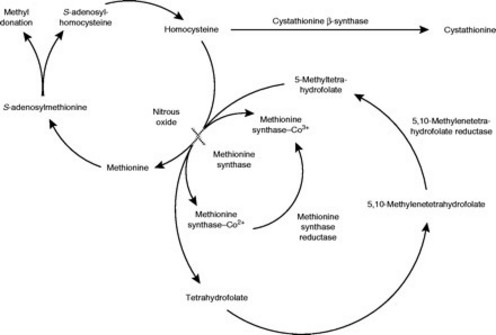(Hyperhomocysteinemia)
Recessive autosomal transmission of a mutation of the MTHFR gene (1p36.3). This enzymatic deficit involves the intracellular metabolism of folic acid in blocking the reduction of 5-10-methyl-tetrahydrofolate into 5-methyl-tetrahydrofolate, a methyl group donor necessary for the remethylation of homocysteine into methionine. This causes a deficiency in methyl-tetrahydrofolate and therefore hyperhomocysteinemia with hypomethioninemia. Polymorphism of this gene causes the production of a form of the enzyme known as 'thermolabile' and thrombophilia. There is no megaloblastic anemia.
Different forms:
- early form: myotonic convulsions, severe hypotonia that evolves to axial hypotonia with peripheral hypertonia. Communicating hydrocephalus probably related to cerebral thrombosis
- late infantile form: progressive encephalopathy starting between 3 months to 10 years of age with neurologic regression and progressive microcephaly
- adult form: mental regression, disorders of stance and schizophrenia-like bhavioral disorder type, sometimes in relation with stroke. Subacute degeneration of the medulla .
Treatment: vitamin B6, vitamin B12, and betaine in order to maintain the plasma level of total homocysteine in the normal range of 15µmol/L.

Anesthetic implications:
significant risk of arterial and venous thrombosis: postpone elective surgery if total homocysteinemia is too high. Provide IV electrolytic glucose-containing fluids and check blood glucose levels as high blood levels of methionine lower glycemia. Avoid N2O because it inhibits the action of methionine synthase and produces an increase in the homocysteine blood level.
References :
- Lowe S, Johnson DA, Tobias JD.
Anesthetic implications of the child with homocystinuria.
J Clin Anesth 1994; 6:142-4.
- Saboul C, Darteyre S, Ged C, Fichtner C, Gay C, Stephan J-L.
Inaugural cerebral sinovenous thrombosis revealing homocystinuria in a 2-year-old boy.
J Child Neurol 2015; 30: 107-112.
- Kar P, Chintha SK, Durga P, Gopinah R.
Pectus carinatum repair in an adolescent with hyperhomocystinaemia: anaesthetic implications.
Indian J Anaesth 2017; 60: 873-5
- Pichardo D, Luginbuehl IA, Shakur Y, Wales PW, El-Sohemy A, O’Connor DL.
Effect of nitrous oxide exposure during surgery on the homocysteine concentrations of children.
Anesthesiology 2012; 117 : 15-21
- Myles PS, Chan MTV, Leslie K, Peyton P, Paech M, Forbes A.
Effect of nitrous oxide on plasma homocysteine and folate in patients undergoing major surgery.
Br J Anaesth 2008; 100:780-6.
- Nagele P, Zeugswetter B, Wiener C, Burger H, Hüpfl M, Mittlböck M, Födinger M.
Influence of methyltetrahydrofolate reductase gene polymorphisms on homocysteine concentrations after nitrous oxide anesthesia.
Anesthesiology 2008; 109:36-43
- Selzer RR, Rosenblatt DS, Laxova R, Hogan K.
Adverse effect of nitrous oxide in a child with 5,10-methylenetetrahydrofolate reductase deficiency.
N Engl J Med 2003; 349: 49-50
- Lacassie HJ, Nazar C, Yonish B, Sandoval P, Muir HA, Mellado P.
Reversible nitrous oxide myelopathy and a polymorphism in the gene encoding 5,10-methylenetetrahydrofolate reductase.
Br J Anaesth 2006; 96: 222-5.
- Ogier de Baulny H, Schiff M, Benoist J-F.
Troubles de la reméthylation.
In Maladies métaboliques héréditaires, par Chabrol B et de Lonlay P, Progrès en Pédiatrie, Doin, 2011, p113-25.
Updated: January 2019